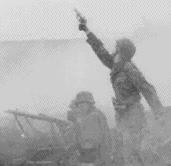Kampfpistole

Now, the so-called Wurfkörper were developed, which were a combination of the head of a hand grenade with a caliber-thick insertion shaft. The first model was the Wurfkörper 358 LP that joined the insertion shaft with the warhead of the regular Stielhandgranate (“stick hand grenade”, the famous “potato-masher”). However the warhead proved too heavy which resulted in a too short range.
The second model, the Wurfkörper 361 LP, joined the shaft with a Eierhandgranate (“egg hand grenade”) and proved more practical. Still some refinement was necessary in regard to stability during flight. In this final refinement the thick wooden shaft discarded after launch and left a thin steel tube that stabilized the projectile satisfactorily. Production ran from 1941 to 1942 and 261,788 WK 361 LP were built.
Several AT – munitions were developed for use with the Kampfpistole. The first AT warhead was developed from the Wurfgranatpatrone 326 LP or WK 326 LP, which was a complicated construction that was stabilized in flight by an assembly with 4 wings. It’s V0 was 72m/s and ranges of up to 400m were reached but the warhead’s explosive content of 12g was considered inadequate. However it was modified into said AT – projectile designated 326 HL/LP (HL = Hohlladung – “hollow charge”). Utilising the general layout of the 326 LP, the new projectile weighed 180g and had a V0 of 60m/s which transformed into a range of 300m. The warhead carried 22g of hexogene as a shaped charge, enabling the 326 HL/LP to penetrate 50mm of armor. A total number of 402,395 WK 326 LP and WK 326 HL/LP were built between 1941 and 1942.
The WK 326 LP and the WK 361 were the only munitions produced for the Kampfpistole concept in considerable quantities. The Kampfpistole was a rather inaccurate weapon with a deviation of 3-4 meters both laterally and longitudinally. It was not too popular among the troops and in 1941, the year of it’s introduction only 5,800 WK 361 LP and 19,750 WK 326 LP were fired; still, by the end of the war all combat munitions for the Kampfpistole had been used up.
Because accuracy at the range of 300m was a real problem that rendered the weapon practically useless at that range for fighting tanks, it was decided to trade the range of the WK 326 HL/LP for a better penetration performance.
The next model after this philosophy was the Wurfmine H 62 LP that resembled the Gewehrgranate 61 except the shaft with a ring stabilizer. It was considered too heavy and impractical due to its unwieldy stabilizing assembly.
Sturmpistole
Development therefore now focused on the Panzerwurfkörper 42 LP that carried a shaped charge of 60g that was able to penetrate 80mm of steel. To achieve the requested range of 75m more propellant was required which in turn made for a heavier recoil that had to be absorbed. The solution was the adding of a folding stock with a shoulder piece that could be screwed to the Kampfpistole and thus the Sturmpistole (“assault pistol”) was born. It later was modified to have a barrel of 18cm; with the longer barrel and the stock unfolded it had an overall length of 58.5 cm and a weight of 2.45kg.
One documented kill is reported from the eastern front in March 1944.
It is unclear how many of the 278,845 Leuchtpistole 42 pistols that were supplied to the army during the war were modified and used as Kampfpistole or Sturmpistole. Total Production of the Leuchtpistole 42 was 417,255; main producers were the companies Waffenfabrik Carl Walther in Zella-Mehlis and Waffenfabrik Erma in Erfurt.
The inaccuracy of the Kampfpistole also led to the development of the so called Sturmbüchse that resembled a triple barreled shotgun and fired a modified version of the WK 361 LP ammunition at ranges of up to 200m. The project was abandoned in spring 1944.
Another development undertaken by the SS was the Kampfpistole Gerloff that used the Gewehrpanzergranate 46 and 61 that too had been developed by the SS. Internal struggles with the army’s weapons bureau prevented a procurement of larger numbers of this weapon.